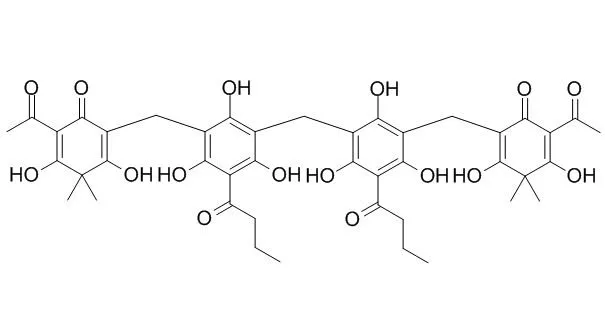| Description: |
Dryocrassin ABBA can significantly suppress tumor growth, without major side effects, it may induce apoptosis in human hepatocellular carcinoma cells through a caspase-mediated mitochondrial pathway. Orally administered dryocrassin ABBA provides mice protection against avian influenza virus H5N1 by inhibiting inflammation and reducing virus loads; dryocrassin ABBA is a potential novel lead compound which has antiviral effects on amantadine-resistant avian influenza virus H5N1 infection. |
| Targets: |
Influenza virus | p53 | Bcl-2/Bax | Caspase | IL Receptor | TNF-α |
| In vitro: |
| Asian Pac J Cancer Prev. 2016;17(4):1823-8. | | Dryocrassin ABBA Induces Apoptosis in Human Hepatocellular Carcinoma HepG2 Cells Through a Caspase-Dependent Mitochondrial Pathway.[Pubmed: 27221859] | Biological and pharmacological activities of Dryocrassin ABBA, a phloroglucinol derivative extracted from Dryopteris crassirhizoma, have attracted attention. In this study, the apoptotic effect of Dryocrassin ABBA on human hepatocellular carcinoma HepG2 cells was investigated.
METHODS AND RESULTS:
We tested the effects of Dryocrassin ABBA on HepG2 in vitro by MTT, flow cytometry, real-time PCR, and Western blotting. KM male mice were used to detect the effect of Dryocrassin ABBA on H22 cells in vivo.
Dryocrassin ABBA inhibited the growth of HepG2 cells in a concentration-dependent manner. After treatment with 25, 50, and 75 μg/mL Dryocrassin ABBA, the cell viability was 68%, 60% and 49%, respectively. Dryocrassin ABBA was able to induce apoptosis, measured by propidium iodide (PI)/annexin V-FITC double staining. The results of real-time PCR and Western ting showed that Dryocrassin ABBA up-regulated p53 and Bax expression and inhibited Bcl-2 expression which led to an activation of caspase-3 and caspase-7 in the cytosol, and then induction of cell apoptosis. In vivo experiments also showed that Dryocrassin ABBA treatment significantly suppressed tumor growth, without major side effects.
CONCLUSIONS:
Overall, these findings provide evidence that Dryocrassin ABBA may induce apoptosis in human hepatocellular carcinoma cells through a caspase-mediated mitochondrial pathway. |
|
| In vivo: |
| Front Microbiol., 2015, 6:592. | | Dryocrassin ABBA, a novel active substance for use against amantadine-resistance H5N1 avian Influenza virus[Reference: WebLink] | The occurrence of multi-drug resistant highly pathogenic avian influenza virus (HPAIV) strains highlights the urgent need for strategies for the prevention and control of avian influenza virus. The aim of our current study is to evaluate the antiviral activity of Dryocrassin ABBA isolated from Rhizoma Dryopteridis Crassirhizomatis (RDC) against an amantadine-resistant H5N1 (A/Chicken/Hebei/706/2005) strain in a mouse model.
METHODS AND RESULTS:
Post inoculation with HPAIV H5N1 virus in mice, the survival rate was 87, 80, and 60% respectively in the 33, 18, and 12.5 mg/kg Dryocrassin ABBA-treated groups. On the other hand, the survival rate was 53 and 20%, respectively in the amantadine-treated group and untreated group. Mice administered with Dryocrassin ABBA or amantadine showed a significant weight increase compared to the untreated group. Moreover, 33 and 18 mg/kg Dryocrassin ABBA have decreased lung index (P >0.05) and virus loads (P <0.01) compared to the untreated group on day 7. Also, on day 7 bronchoalveolar lavage fluid pro-inflammatory cytokines (IL-6, TNF-α, and IFN-γ) decreased significantly (P <0.01) while anti-inflammatory cytokines (IL-10 and MCP-1) were increased significantly (P <0.01) in the 33 and 18 mg/kg Dryocrassin ABBA-treated groups compared to the amantadine group and the untreated group. Moreover, the concentrations of IL-12 in drug-treated groups were significantly (P < 0.01) lowered compared with the untreated group.
CONCLUSIONS:
Based on the above we conclude that orally administered Dryocrassin ABBA provided mice protection against avian influenza virus H5N1 by inhibiting inflammation and reducing virus loads.
Dryocrassin ABBA is a potential novel lead compound which had antiviral effects on amantadine-resistant avian influenza virus H5N1 infection. |
|






 Cell. 2018 Jan 11;172(1-2):249-261.e12. doi: 10.1016/j.cell.2017.12.019.IF=36.216(2019)
Cell. 2018 Jan 11;172(1-2):249-261.e12. doi: 10.1016/j.cell.2017.12.019.IF=36.216(2019) Cell Metab. 2020 Mar 3;31(3):534-548.e5. doi: 10.1016/j.cmet.2020.01.002.IF=22.415(2019)
Cell Metab. 2020 Mar 3;31(3):534-548.e5. doi: 10.1016/j.cmet.2020.01.002.IF=22.415(2019) Mol Cell. 2017 Nov 16;68(4):673-685.e6. doi: 10.1016/j.molcel.2017.10.022.IF=14.548(2019)
Mol Cell. 2017 Nov 16;68(4):673-685.e6. doi: 10.1016/j.molcel.2017.10.022.IF=14.548(2019)